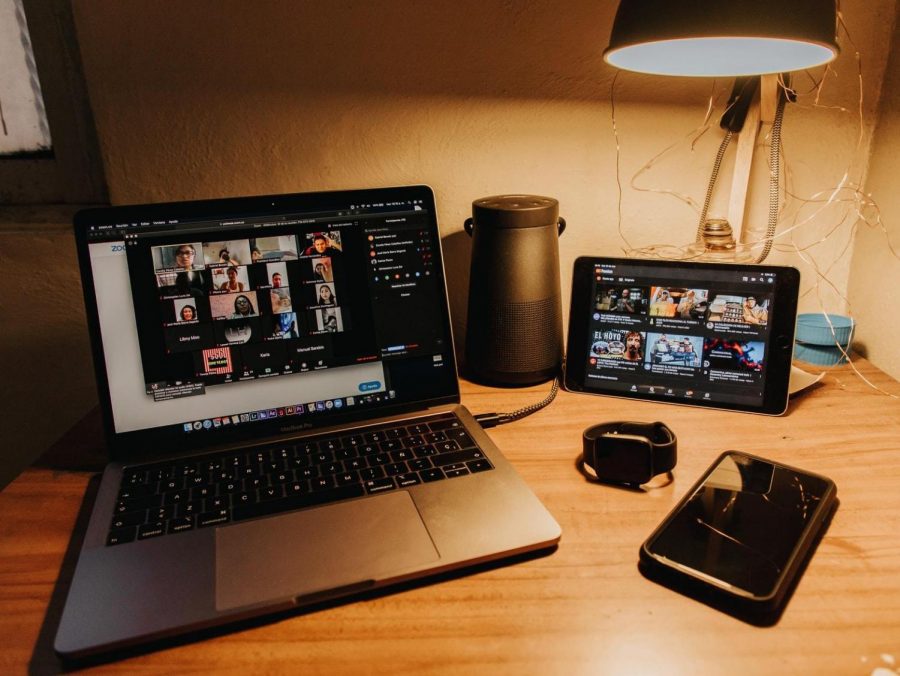Virtual School and its Impact on Students
December 8, 2020
As students wake up to the beginning of another school week in their soundless bedrooms, warmly tucked away and immersed in their softly knitted sheets extending over their rested faces, they block out the sunlight shining between the cracks of their windows, hoping to snooze a little while longer.
Their desks, where virtual learning takes place, lies just a few steps away. Being the typical day for most nowadays, students have noticed a drastic change in their work styles as they move from in person school to online learning during the COVID-19 pandemic.
Students across the country and many different regions of the world are experiencing changes in their way of learning as the pandemic becomes more and more severe. Fearing that the consequences of the rapid spreading virus could be very serious for them and their families, students understand the option they are given to continue with their journey through education. Now that learning through a computer screen and gazing blankly at small pixelated peers and teachers is the new normal, students have a first hand perspective on the academic repercussions of Covid-19.
Transitioning from learning in an environment surrounded by other chattering students and teachers with gleaming smiles in the same room, to sitting in solidarity in their isolated bedrooms at home, has opened students’ eyes as to how these changes affect them personally. Taking many facts into consideration, this turn of events has even caused them to wonder if this new way of education has some conveniences. Although some students have used the quarantine to sleep in and procrastinate on the work that continuously piles up like autumn leaves, as the week moves forward, many are taking advantage of having the extra time to work.
Completing work from home is quite different from attending school in person, but for numerous students, this change in learning provides them with “the opportunity to focus more on assignments,” Janessa Montilla, a PPCHS freshman, claims. Janessa is one of the many students who now realizes that opening your laptop to a virtual class isn’t so abominable after all.
Participating in online zoom classes, Janessa notices that the “teachers give students more time to finish work throughout the day.” Using approximately half of the class time for the interactive lesson, the rest of the time can be used for unfinished assignments and studying for upcoming exams. Aidan Suarez, a student at Belen Jesuit Preparatory School, shares his thoughts on virtual learning as well. For the sophomore, working at home is “a more streamlined approach to learning” and since all tasks are completed “in one place,” no time is being wasted.
Typically, the extensive commute to school in overwhelming traffic during rush hour, walking from class to class between the herds of shoulder shoving students in a sea of densely packed bookbags, and getting caught up in gossip filled conversations, are enough to hinder students from completing all their assignments in a timely manner. These common distractions won’t be an issue with school at home.
Providing an opposing perspective on virtual school, Kiley Irizarry, a Pines Charter freshman, would much rather attend in person school than online learning. With all the virus madness and dedicating a grand amount of time to virtual learning, the newly welcomed high schooler believes that socializing with classmates and friends isn’t as easy as it sounds, which usually would help ease the stress of a laborious day of school work. As someone who feels a “huge barrier” that prevents her from connecting with peers her age, Irizarry has realized how it feels “so isolating when it comes to learning online” she continues that “it’s just the way it is right now.” Understanding that this current situation isn’t permanent is definitely allowing students to take an optimistic view at this uncertain time in our lives.
To fill the social void, students currently have and are making the best of things through computer services like Zoom and FaceTime, which have been a great help; however, talking to a miniature version of your best friends can only go so far, and students are still held back from participating in the enjoyable extra-curricular activities that high school students are so fond of, such as “[going] to football games or [hanging] out with friends after class,” ninth grader Kiley clarifies.
Students are able to recognize that it’s now “easier to get ready in the day,” but since they “can’t see [their] friends” as Jennifer Thompson states, it is taking a toll on the mental health of students. Fortunately, schools like Pines Charter are now introducing their students to a beneficial service called The Oasis where they can relax their overworked minds, which are perpetually thinking like a hamster running on a wheel before the academically challenging day that lies ahead of them. This way, they can be motivated to get “straight to homework” as Aidan Suarez points out.
With the many drawbacks that the coronavirus pandemic brings along, students are looking at virtual schooling with a different perspective. Even though education through the Internet has been successful overall in South Florida, students, parents and educators are hopeful we will return to normalcy sometime next year with the release of the highly anticipated vaccine.







